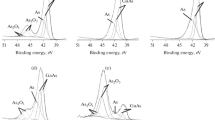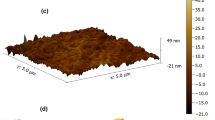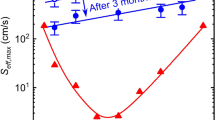Abstract
Some of the III–V semiconductor used in various devices suffer from the surface high density of states limiting their application. This study compares and evaluates five different ammonium sulfide passivation methods on GaAs surface with the aim to enhance the electrical characteristics of Au|n-GaAs Schottky junction. Wet chemical passivation of the n-GaAs surface was carried out by dipping the samples in saturated ammonium sulfide solutions at various temperatures and for various times. We also used acidic cleaning to improve the device performance. Our investigation shows a noticeable improvement in the electrical characteristics of the device reported here using acidic cleaning and ammonium sulfide passivation methods. A 23% increase in Schottky barrier height is found, which is much higher than that reported in the literature. Further, we measured a reduction of around three orders of magnitudes in saturation current as well as improvement in ideality factor to 1.23 for the best conditions of surface acidic cleaning and passivation. X-ray photoelectron spectroscopy study revealed a suppression of oxide layer by introduction of sulfide species in GaAs surface after the passivation. The lowest concentration of oxygen was found on the surface of the sample passivated under the optimum condition.







Similar content being viewed by others
REFERENCES
X. Jiang, F. Tang, Q. Xie, P. Calka, S.-H. Jung, and M. E. Givens, ASM IP Holding B. V. Almere, NL, USA (2018).
C. Al-Amin, M. Karabiyik, P. K. Vabbina, R. Sinha, and N. Pala, Nanomaterials 6 (6), 86 (2016).
E. V. Lutsenko, M. V. Rzheutski, A. G. Vainilovich, I. E. Svitsiankou, V. A. Shulenkova, E. V. Muravitskaya, A. N. Alexeev, S. I. Petrov, and G. P. Yablonskii, Semiconductors 52, 2107 (2018).
V. N. Bessolov, E. V. Konenkova, T. A. Orlova, S. N. Rodin, N. V. Seredova, A. V. Solomnikova, M. P. Shcheglov, D. S. Kibalov, and V. K. Smirnov, Semiconductors 53, 989 (2019).
Y. Ke, S. Milano, X. W. Wang, N. Tao, and Y. Darici, Surf. Sci. 415, 29 (1998).
W. Wang, G. Lee, M. Huang, R. M. Wallace, and K. Cho, J. Appl. Phys. 107, 103720 (2010).
A. Ohtake, G. Shunji, and J. Nakamura, Sci. Rep. 8, 1 (2018).
N. X. Xue Chen, Z. Yang, F. Gong, Z. Wei, D. Wang, J. Tang, X. Fang, D. Fang, and L. Liao, Nanotechnology 29, 1 (2018).
F. Chen, J. L. Tang, G. J. Liu, D. Fang, X. Gao, Z. K. Xu, X. Fang, X. H. Ma, L. Xu, X. H. Wang, and Z. P. Wei, Adv. Mater. Res. 1118, 154 (2015).
M. V. Lebedev, T. V. Lvova, A. L. Shakhmin, O. V. Rakhimova, P. A. Dementev, and I. V. Sedova, Semiconductors 53, 892 (2019).
T. V. Lvova, A. L. Shakhmin, I. V. Sedova, and M. V. Lebedev, Appl. Surf. Sci. 311, 300 (2014).
S. L. Heslop, L. Peckler, and A. J. Muscat, J. Vacuum Sci. Technol. A 35, 03E110 (2017).
S. Jiang, G. He, S. Liang, L. Zhu, W. Li, C. Zheng, J. Lv, and M. Liu, J. Alloys Compd. 704, 322 (2017).
S. Subramanian, E. Y.-J. Kong, D. Li, S. Wicaksono, S. F. Yoon, and Y. C. Yeo, IEEE Trans. Electron Dev. 61, 2767 (2014).
S. Kumar, S. Kumari, S. K. Jangir, R. K. Pandey, A. Goyal, G. Upadhyay, P. Mishra, T. Srinivasan, and A. K. Mahapatro, Integr. Ferroelectr. 186, 77 (2018).
H. Zhang, J. Yang, J.-R. Chen, J. R. Engstrom, T. Hanrath, and F. W. Wise, J. Phys. Chem. Lett. 7, 642 (2016).
R. Ghita, C. Negrila, C. Cotirlan, and C. Logofatu, Digest J. Nanomater. Biostruct. 8, 1335 (2013).
K. Sato, M. Sakata, and H. Ikoma, Jpn. J. Appl. Phys. 32, 3354 (1993).
L. Zhou, B. Bo, X. Yan, C. Wang, Y. Chi, and X. Yang, Crystals 8, 226 (2018).
K. Hwang and S. S. Li, J. Appl. Phys. 67, 2162 (1990).
A. Salehi and A. Nikfarjam, Sens. Actuators, B 101, 394 (2004).
A. Salehi, A. Nikfarjam, and D. J. Kalantari, IEEE Sens. J. 6, 1415 (2006).
T. Kuan, P. Batson, T. Jackson, H. Rupprecht, and E. Wilkie, J. Appl. Phys. 54, 6952 (1983).
D. H. van Dorp, S. Arnauts, M. Laitinen, T. Sajavaara, J. Meersschaut, T. Conard, F. Holsteyns, and J. Kelly, Solid State Phenom. 282, 48 (2018).
S. Aithal and J. J. Dubowski, Appl. Phys. Lett. 112, 153102 (2018).
P. S. Das and A. Biswas, Appl. Phys. A 118, 967 (2015).
L. Chen, Z. Yu-Ming, Z. Yi-Men, and L. Hong-Liang, Chin. Phys. B 22, 076701 (2013).
S. M. Sze and K. K. Ng, Physics of Semiconductor Devices (Wiley, New York, 2006).
D. K. Schroder, Semiconductor Material and Device Characterization (Wiley, New York, 2006).
J. Behnejad, A. Salehi, and H. Mahmoodnia, in Iranian IEEE Conference on Electrical Engineering ICEE, 2017 (2017), p. 283.
W. Jin, Y. Liu, K. Yuan, K. Zhang, Y. Ye, W. Wei, and L. Dai, IEEE Electron Dev. Lett. 40, 119 (2019).
A. Kırsoy, M. Ahmetoglu, A. Asimov, and B. Kucur, Acta Phys. Polon. A 128, B-170 (2015).
N. Fairley, Casa Software Ltd., 2005. http://www.casaxps.com.
C. Spindt, R. Besser, R. Cao, K. Miyano, C. Helms, and W. Spicer, Appl. Phys. Lett. 54, 1148 (1989).
H. A. Budz, M. C. Biesinger, and R. R. LaPierre, J. Vacuum Sci. Technol. B 27, 637 (2009).
S. C. Ghosh, M. C. Biesinger, R. R. LaPierre, and P. Kruse, J. Appl. Phys. 101, 114322 (2007).
Author information
Authors and Affiliations
Corresponding author
Ethics declarations
The authors declare that they have no conflict of interest.
Rights and permissions
About this article
Cite this article
Mahmoodnia, H., Salehi, A. & Mastelaro, V.R. GaAs Semiconductor Passivated by (NH4)2Sx: Analysis of Different Passivation Methods Using Electrical Characteristics and XPS Measurements. Semiconductors 54, 817–826 (2020). https://doi.org/10.1134/S106378262007009X
Received:
Revised:
Accepted:
Published:
Issue Date:
DOI: https://doi.org/10.1134/S106378262007009X




